An Introduction to the Master of the Horizon

Jan Frans van Bloemen, a name synonymous with the sweeping vistas of the Roman countryside, stands as a significant figure in the history of European landscape painting. Born in Antwerp in 1662, he spent the vast majority of his prolific career in Rome, capturing the beauty, grandeur, and timeless allure of the Italian landscape. His remarkable ability to depict expansive, light-filled horizons earned him the evocative nickname "Orizzonte" from his Italian peers, a testament to the defining characteristic of his art. Active during the late Baroque and early Rococo periods, Van Bloemen skillfully blended his native Flemish traditions with the prevailing classical ideals of Italian landscape art, creating a unique and highly sought-after style. He died in Rome in 1749, leaving behind a rich legacy of works that continue to enchant viewers with their atmospheric depth and picturesque charm.
Early Life and Artistic Formation in Antwerp
Jan Frans van Bloemen's journey into the world of art began in the bustling port city of Antwerp, a major artistic hub in the Southern Netherlands (Flanders). Born into a family of painters, art was likely a constant presence in his early life. His primary artistic education came from his elder brother, Pieter van Bloemen. Pieter, who would later gain fame under the nickname "Standaart," specialized in military scenes, animal paintings, and landscapes, providing Jan Frans with a solid foundation in the Flemish artistic tradition, known for its attention to detail and naturalism.
Further honing his skills, Jan Frans undertook an apprenticeship with Antoine Goubau. Goubau was an established Antwerp master known for his Italianate landscapes and genre scenes, often depicting Roman markets or architectural settings populated with figures. This training under Goubau would have exposed the young Van Bloemen to the Italianate style even before leaving Flanders, likely sparking his interest in the landscapes and classical ruins of Italy, and refining his technique in composition and the rendering of light and space. This combination of familial instruction and formal apprenticeship equipped him with the technical proficiency and artistic sensibilities necessary for his future success.
The Journey South: To Lyon and Rome
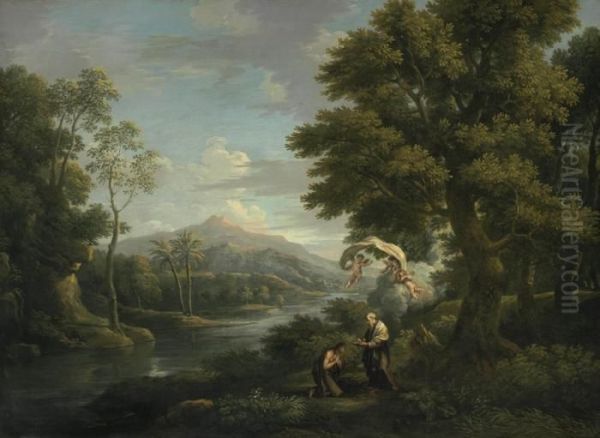
Around the mid-1680s, seeking broader horizons and direct exposure to the classical world that so inspired landscape painters, Jan Frans van Bloemen embarked on a journey southward. He traveled with his brother Pieter, whose own artistic ambitions also drew him towards Italy. Their initial destination was Lyon in France, a city with its own vibrant artistic community and a common stopping point for artists heading towards Rome. The time spent in Lyon, though perhaps brief, would have offered further exposure to different artistic currents.
The ultimate goal, however, was Rome. Arriving in the Eternal City likely around 1686 or shortly thereafter, the Van Bloemen brothers entered the heart of the European art world. Rome was not only rich in the physical remnants of antiquity and the masterpieces of the Renaissance and Baroque periods but also a melting pot of international artists. For a landscape painter like Jan Frans, the city and its surrounding countryside, the Campagna, offered inexhaustible inspiration. This move marked the beginning of the most significant phase of his career, where he would fully develop his signature style and establish his reputation.
Establishing a Career in the Eternal City
Upon settling in Rome, Jan Frans van Bloemen quickly integrated into the city's vibrant artistic milieu. He became associated with the 'Schildersbent,' later known as the 'Bentvueghels' ('Birds of a Feather'). This was an informal association primarily composed of Dutch and Flemish artists working in Rome, known for its bohemian camaraderie and sometimes boisterous initiation rituals. Within this group, artists often received characteristic nicknames; it was likely here, among his Northern European peers, that Jan Frans was dubbed "Orizzonte," acknowledging his mastery of depicting deep, atmospheric distances in his landscapes.
Van Bloemen's talent did not go unnoticed by the Roman aristocracy and clergy, who were avid collectors of art. He found favour among prominent patrons, most notably the powerful Ruspoli family. The Ruspoli were significant patrons of the arts, and their extensive commissions provided Van Bloemen with financial stability and enhanced his reputation. His paintings, evoking the beauty and serenity of the Roman Campagna, resonated with the tastes of the elite, who often adorned their palaces and villas with such idyllic scenes. He remained in Rome for the rest of his life, a respected member of the art community, continuously painting the landscapes that had become his hallmark.
Orizzonte's Signature Style: Blending North and South

The art of Jan Frans van Bloemen is characterized by a masterful synthesis of his Flemish origins and the influences he absorbed in Italy. His nickname, "Orizzonte," points directly to the most celebrated aspect of his work: the creation of vast, panoramic landscapes stretching towards a distant, luminous horizon. This sense of expansive space, often bathed in a soft, atmospheric light, became his trademark. His compositions typically follow the classical landscape tradition, often structured with framing elements like trees or ruins in the foreground, leading the viewer's eye through receding planes into the deep background.
The profound impact of the French painter Gaspard Dughet (also known as Gaspard Poussin, brother-in-law of Nicolas Poussin), who spent most of his life in Rome, is evident in Van Bloemen's work. Dughet was a master of the classical landscape, depicting the Roman Campagna with a sense of structured grandeur and naturalistic detail. Van Bloemen adopted Dughet's compositional strategies and his focus on the specific topography around Rome. Comparisons are also frequently drawn with Claude Lorrain, the supreme master of the idealized, light-filled landscape, although Van Bloemen often retained a greater degree of topographical accuracy and Flemish attention to detail in foliage and texture compared to Claude's more poetic generalizations.
While embracing the classical structure and idealized beauty associated with Dughet and Lorrain, Van Bloemen never fully abandoned his Flemish roots. His paintings often exhibit a meticulous rendering of natural details – the specific forms of trees, the texture of rocks, the play of light on water – that speaks to his Northern training. His colour palettes could range from the warm, golden tones reminiscent of Claude Lorrain to cooler, silvery blues and greens, particularly effective in capturing the specific atmospheric conditions of the Roman Campagna. Sources suggest his style evolved, moving from a more dynamic and analytical approach in his earlier Roman years towards a calmer, more synthesized, and perhaps more serene vision from around 1730 onwards.
Favourite Themes: The Roman Campagna and City Views
Jan Frans van Bloemen dedicated much of his artistic output to celebrating the landscape surrounding Rome – the Campagna. This area, rich with rolling hills, meandering rivers like the Tiber and Aniene, ancient aqueducts, and picturesque towns like Tivoli and Frascati nestled in the Alban Hills, provided him with endless subject matter. He captured its varied moods, from sun-drenched afternoons to tranquil mornings, often populating these scenes with small figures – shepherds, travellers, or mythological characters – that add scale and narrative interest, though the landscape itself always remained the primary focus.
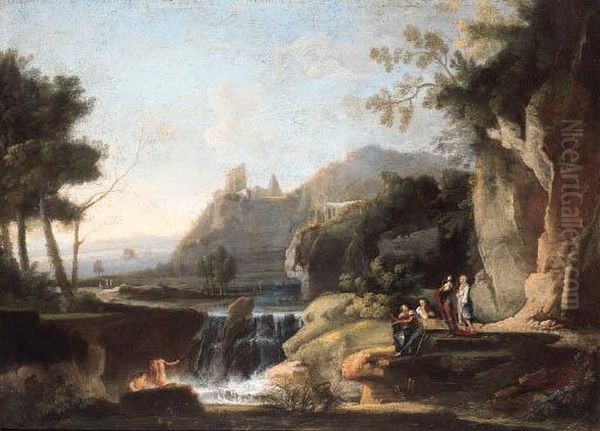
His depictions were not always strictly topographical representations. While often based on real locations, Van Bloemen frequently employed artistic license, rearranging elements or combining features from different places to create an idealized or more compositionally harmonious view. This blend of observation and invention is characteristic of classical landscape painting. He was particularly adept at incorporating classical ruins – temples, tombs, bridges, and aqueducts – into his landscapes. These remnants of antiquity added a sense of historical depth and melancholy grandeur, evoking the Arcadian ideal popular at the time.
Beyond the Campagna, Van Bloemen also produced views (vedute) of Rome itself. These could range from panoramic vistas showing the city skyline dotted with its famous domes and monuments, often taken from elevated viewpoints like the Janiculum or Palatine Hill, to more focused depictions of specific architectural landmarks or picturesque corners within the city. These urban views, like his rural landscapes, demonstrate his skill in rendering perspective, architectural detail, and atmospheric effects, contributing to the genre of view painting that would become even more prominent later in the 18th century with artists like Canaletto and Francesco Guardi in Venice, and Giovanni Paolo Panini in Rome.
A Network of Collaboration
In the collaborative spirit common in the Baroque era, Jan Frans van Bloemen frequently worked with other artists, particularly figure specialists (figuristi), who would paint the small human or mythological figures (staffage) within his expansive landscapes. This practice allowed each artist to focus on their area of expertise, resulting in a more polished final product. His most consistent collaborator was his own brother, Pieter van Bloemen ("Standaart"). Having travelled and settled in Rome together, their artistic partnership was natural. Pieter's skill in depicting figures, animals, and genre elements complemented Jan Frans's mastery of landscape, and numerous works are documented as joint efforts, such as the Vue de Vignanelle.
Beyond his brother, Orizzonte collaborated with several prominent Italian painters active in Rome. The celebrated Carlo Maratti, a leading figure in Roman painting at the turn of the 18th century, is known to have occasionally provided figures for Van Bloemen's landscapes. This association with such a high-status artist undoubtedly enhanced Van Bloemen's own standing. Other notable collaborators included Placido Costanzi, a versatile painter known for both historical subjects and portraits, who worked with Van Bloemen on pieces like the Panoramic View of Rome from the Palatine Hill. The internationally renowned portraitist Pompeo Batoni, a leading figure in Roman painting later in Van Bloemen's career, is also mentioned as having added figures to some of Orizzonte's canvases. These collaborations underscore Van Bloemen's integration into the highest levels of the Roman art world.
Masterpieces and Representative Works
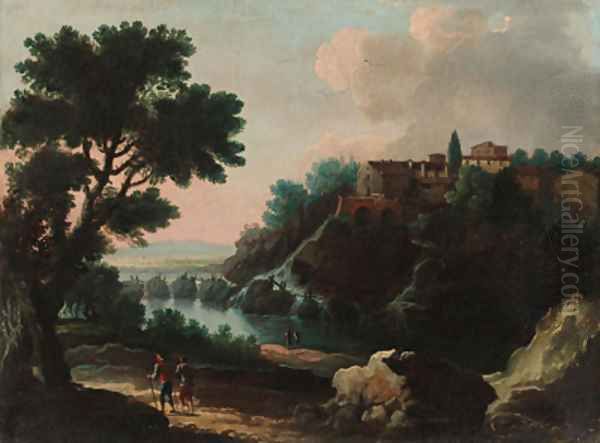
While Jan Frans van Bloemen produced a large body of work, several paintings stand out as particularly representative of his style and skill. The Roman Countryside Landscape (Vignanello), housed in the Fondazione Custodia in Paris, exemplifies his mature style. It presents a sweeping, idealized view of the Italian countryside, likely inspired by the area around Vignanello north of Rome, showcasing his characteristic deep perspective, atmospheric light, and classically balanced composition. The figures within, possibly added by his brother Pieter, are seamlessly integrated into the vast natural setting.
Another significant work is the Panoramic View of Rome from the Palatine Hill, a collaborative effort with Placido Costanzi. This painting offers a stunning vista of the city, demonstrating Van Bloemen's ability to handle complex urban topography and architectural detail on a grand scale, combined with Costanzi's elegant figures. The Imaginary View of the Roman "Campagna", found in The Walters Art Museum in Baltimore, highlights his ability to blend real elements with imaginative composition, creating a picturesque scene complete with classical ruins and serene pastoral figures, embodying the Arcadian ideal.
The Metropolitan Museum of Art in New York holds the Landscape with the Communion of Saint Mary of Egypt, a work that combines religious narrative with a dramatic landscape setting. The vast, somewhat wild landscape serves as a powerful backdrop to the spiritual event depicted by the figure painter (potentially Costanzi or another collaborator). Works like Landscape with a Fountain (private collection) showcase his ability to create intimate, charming scenes within his broader landscape repertoire. While attributions can sometimes be complex, especially regarding collaborations, these works collectively demonstrate the range and quality of Orizzonte's output.
Recognition, Reputation, and Legacy
During his lifetime, Jan Frans van Bloemen achieved considerable fame and success in Rome. His landscapes were highly sought after by collectors, both Italian and foreign visitors undertaking the Grand Tour. His reputation placed him among the leading landscape specialists in the city, often mentioned in the same breath as the masters who influenced him, Gaspard Dughet and Claude Lorrain. His ability to capture the specific light and atmosphere of the Roman Campagna, combined with pleasing classical compositions, perfectly suited the tastes of the era.
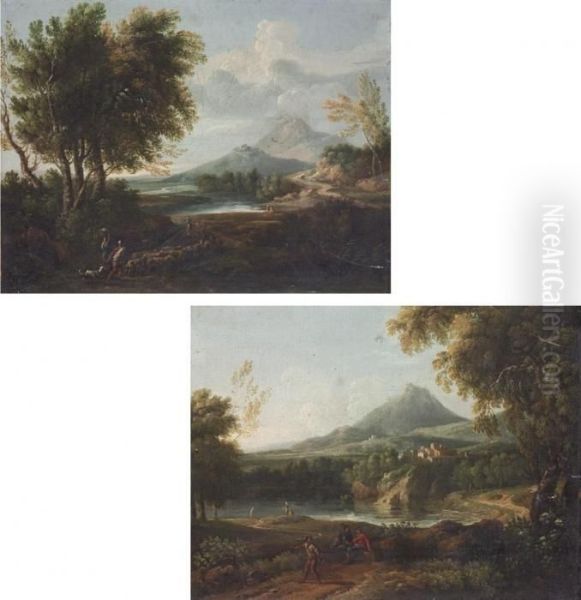
Despite his artistic success and renown, official recognition from Rome's premier artistic institution, the Accademia di San Luca, came relatively late in his life. He was finally admitted as a member in 1742, when he was already eighty years old. The reasons for this delay are not entirely clear but may relate to internal politics within the Academy, potential past disagreements stemming from his association with the somewhat anti-establishment Schildersbent, or the traditional academic hierarchy that often valued history painting above landscape painting.
Nevertheless, his late admission confirmed his established status. Van Bloemen's influence extended to subsequent generations of landscape painters working in Italy. His particular blend of Flemish detail and classical structure provided a model for many artists depicting the Roman scene. His works continued to be collected and admired throughout the 18th and 19th centuries, solidifying his legacy as a key figure in the development of European landscape painting and one of the most evocative interpreters of the Italian landscape.
The Van Bloemen Artistic Dynasty
Jan Frans van Bloemen was part of a notable family of artists. His elder brother, Pieter van Bloemen (1657-1720), known as "Standaart" (presumably referring to the standards or flags often depicted in his military scenes), was Jan Frans's first teacher and travelling companion to Rome. Pieter established his own successful career, specializing in battle scenes, cavalry skirmishes, animal paintings, and genre scenes set in Roman markets or camps. His style, while also influenced by Italy, retained a distinct Flemish character, particularly in its lively detail and dynamic compositions. As noted, he frequently collaborated with Jan Frans, adding figures and animals to his brother's landscapes.
There was also a younger brother, Norbert van Bloemen (1670-1746), nicknamed "Cephalus." Norbert followed his brothers to Rome but eventually settled in Amsterdam. He specialized primarily in genre scenes, often depicting Italianate peasant life, interiors, and market scenes, sometimes reminiscent of the Dutch Bamboccianti painters who worked in Rome earlier in the 17th century, like Pieter van Laer. While perhaps less famous than his two elder brothers, Norbert contributed to the family's artistic output. Together, the three Van Bloemen brothers represent a significant Flemish presence in the Italian and broader European art scene of the late 17th and early 18th centuries, with Jan Frans "Orizzonte" achieving the most lasting fame specifically for his mastery of landscape.
Where to Find Orizzonte's Work Today
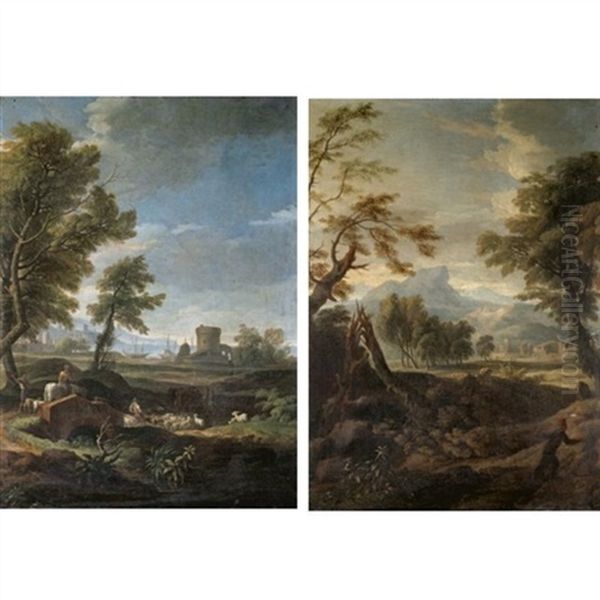
Works by Jan Frans van Bloemen are housed in numerous prestigious museums and galleries across Europe and North America, as well as in private collections. In Italy, the Doria Pamphilj Gallery in Rome holds a significant collection, reflecting the kind of aristocratic patronage he enjoyed during his lifetime. His paintings can also be found in other Italian collections. As mentioned, the Fondazione Custodia in Paris holds the notable Vignanello landscape. German museums, such as the Museum der bildenden Künste in Leipzig, also possess examples of his work.
In the United Kingdom, his paintings entered collections partly through the Grand Tour market; examples can be found in various regional museums and historic houses. The Fitzwilliam Museum in Cambridge holds works attributed to the Van Bloemen family, though care must be taken with attributions between the brothers, especially regarding genre scenes or still lifes which might be Norbert's. In the United States, The Metropolitan Museum of Art in New York and The Walters Art Museum in Baltimore are among the institutions holding fine examples of his landscapes. His works also continue to appear on the art market, occasionally surfacing at major auctions, like the mentioned The Walls of Colosseum, Rome, although the current whereabouts of such pieces sold privately or at auction are not always publicly known. The dispersal of his works reflects his international appeal both during his life and subsequently.
Orizzonte in the Wider Artistic Context
Jan Frans van Bloemen operated within a rich and competitive artistic environment. In Rome, his primary point of reference and influence was Gaspard Dughet, whose classical yet naturalistic depictions of the Campagna set a standard. He also worked in the long shadow of Claude Lorrain, whose idealized visions represented a pinnacle of landscape painting. While influenced by both, Orizzonte carved his own niche, perhaps offering a slightly more direct, less overtly poetic rendering of the Roman landscape than Claude, while still imbuing it with classical harmony.
Among his contemporaries in Rome specializing in landscape or view painting, Andrea Locatelli stands out as a potential competitor. Locatelli, initially influenced by Van Bloemen, later developed a lighter, more Rococo style. Giovanni Paolo Panini, slightly younger, became the preeminent painter of Roman ruins and city views (vedute), though his focus was often more architectural than Van Bloemen's typically landscape-dominant approach. The presence of other Northern artists in Rome, like fellow Fleming Jacob de Heusch, also contributed to the diverse landscape painting scene.
It is also useful to contrast Van Bloemen's work with the very different artistic concerns prevailing in his homeland and the Dutch Republic during the preceding Golden Age. While Dutch masters like Johannes Vermeer focused on intimate interior scenes and Rembrandt van Rijn explored profound human psychology through portraiture and biblical narratives, Van Bloemen dedicated himself to the classical landscape tradition as practiced in Italy. His career exemplifies the enduring allure of Italy, particularly Rome, for artists from across Europe, and his success demonstrates the continued vitality of landscape painting within the Baroque and emerging Rococo periods.
Conclusion: An Enduring Vision of Rome
Jan Frans van Bloemen, "Orizzonte," remains a pivotal figure in the history of landscape painting. His long and productive career in Rome resulted in a vast oeuvre that captured the enduring beauty of the city and its surrounding Campagna. By skillfully merging the detailed naturalism of his Flemish heritage with the classical compositional structures and atmospheric light perfected by masters like Gaspard Dughet and Claude Lorrain, he created landscapes that were both topographically recognizable and ideally harmonious. His nickname perfectly encapsulates his achievement: the ability to draw the viewer's eye across serene plains and rolling hills towards distant, light-filled horizons. Through his numerous canvases, collaborations with esteemed colleagues like Carlo Maratti and Placido Costanzi, and influence on subsequent painters, Van Bloemen left an indelible mark on the Roman art scene and secured his place as one of the most accomplished and appealing landscape painters of his era. His visions of Italy continue to resonate, offering timeless glimpses into the picturesque world of the Roman Baroque.